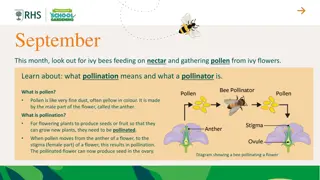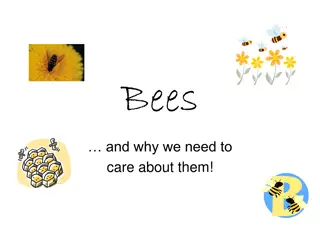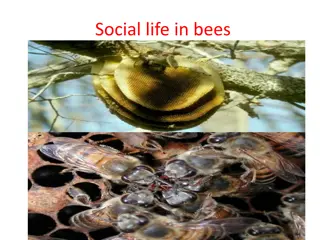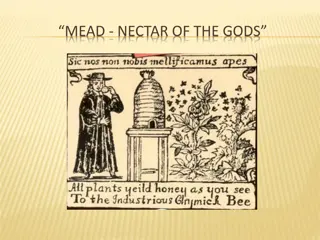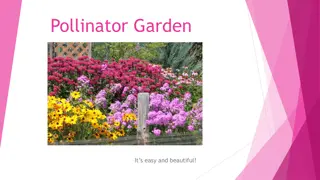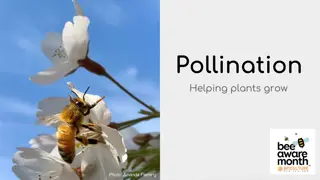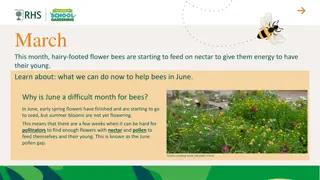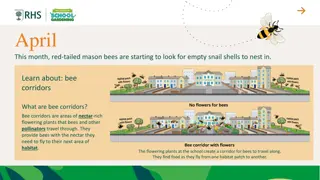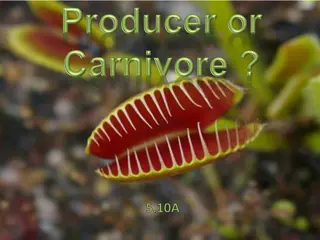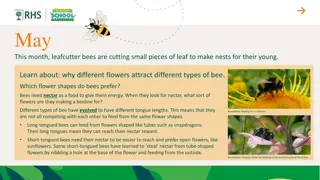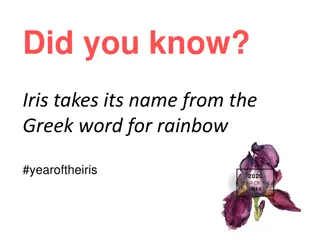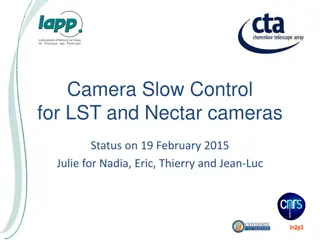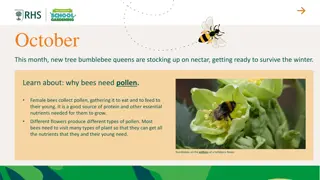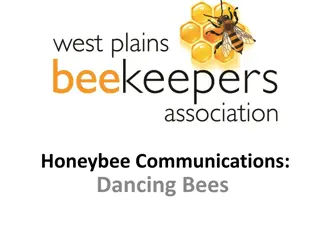Understanding Pollination: The Role of Pollinators in Plant Growth
In September, watch out for ivy bees feeding on nectar and gathering pollen from ivy flowers. Explore the significance of pollination, pollen, and pollinators in the plant life cycle. Discover how bees and other pollinators play a crucial role in food production and biodiversity. Engage in activitie
2 views • 9 slides
Importance of Bees: Why We Need to Care About Them
Bees are essential pollinators, with various species playing crucial roles in ecosystems. They forage for pollen and nectar, create honey, and live in diverse habitats. Bumble bees, honey bees, and solitary bees each have unique characteristics and contribute to biodiversity. However, bees face thre
6 views • 21 slides
Understanding the Social Life of Bees
Honeybees exhibit highly organized social behavior within their colonies, comprising a queen, drones, and worker bees. The queen lays eggs and emits pheromones to regulate worker behavior. Worker bees collect nectar to produce honey, a beneficial substance rich in essential nutrients. Various specie
1 views • 17 slides
Unveiling the Secrets of Mead: History, Making Process, and Fermentation
Delve into the world of mead, the ancient nectar of the gods, as we uncover its rich history dating back to the Paleolithic Period. Learn about the simple ingredients used in mead making, the role of yeast in fermentation, and the preservation benefits of this divine beverage. Explore the wisdom beh
9 views • 24 slides
Create a Pollinator Garden: Easy and Beautiful Tips
Design your own pollinator garden to attract butterflies, bees, and other pollinators with nectar and pollen sources. Learn about the benefits of native plants, planting strategies, and a variety of flowers to create a vibrant and thriving garden that supports biodiversity.
1 views • 7 slides
Honey Bee Exposure to Pesticides: Routes and Impacts
Analysis by the U.S. Environmental Protection Agency outlines various exposure routes of honey bees to pesticides, including contact with contaminated sources like foliage and soil, ingestion of contaminated pollen and nectar, and inhalation of chemical droplets. Different application types and age
2 views • 13 slides
Understanding Pollination: How Bees Help Plants Grow
Discover the fascinating relationship between bees and flowers, where bees play a vital role in pollination, aiding in the growth of plants and the production of fruits and seeds. Explore how bees need flowers for pollen and nectar, and how plants rely on bees to spread their pollen for reproduction
0 views • 10 slides
Understanding the Vital Relationship Between Bees and Flowers
Explore the significance of bees in pollination, the role of pollen in flower reproduction, and how bees contribute to plant growth. Dive into the world of nectar collection, honey production, and the mutualistic relationship between insects and flowers. Discover the essential interdependence betwee
0 views • 15 slides
Helping Bees in June: Bridging the Pollen Gap
In June, bees face challenges due to the pollen gap between spring and summer blooms. By sowing flowering plant seeds in March and letting grass patches grow with dandelions and daisies, we can provide vital nectar and pollen sources for bees to thrive. Engage your school community in planting activ
0 views • 8 slides
Creating Bee Corridors for Pollinator Conservation
Red-tailed mason bees are starting to nest in empty snail shells this month. Learn about bee corridors, areas of nectar-rich plants that help bees move between habitats. The need for bee corridors is highlighted as urbanization reduces natural habitats. Activities like creating bee corridors, allowi
0 views • 7 slides
The Fascinating Venus Flytrap: A Carnivorous Plant Adapted to Bog Life
The Venus flytrap, known for its unique features, resides in bogs and has adapted its carnivorous nature to survive. By utilizing its hinged leaves as traps, attracting insects with nectar, and digesting them for nutrients, this plant showcases its evolutionary strategies.
0 views • 11 slides
Understanding Bee-Friendly Flowers and Nectar Preferences
Leafcutter bees are busy making nests this month, highlighting the importance of flowers in attracting different bee species based on shapes, nectar availability, and tongue lengths. Different bees prefer various flower shapes for nectar, with long-tongued bees favoring tube-shaped flowers like snap
0 views • 5 slides
Fascinating Facts About Irises - Year of the Iris
Irises, named after the Greek word for rainbow, are stunning flowers with unique characteristics. They feature three upward petals called standards and three downward sepals known as falls. The sepals act as landing pads for pollinators, guiding them towards nectar. Irises come in a variety of color
0 views • 9 slides
Status Update on Camera Control and Integration of Equipment
Updates on camera control systems for LST and Nectar cameras, integration of equipment such as cRIO, Beagle Bone Black, sensor boards, power supply units, and environment sensors. The ECC software architecture evolution to address compatibility issues with OPCUA SDK libraries. Discussions on power d
0 views • 7 slides
Understanding the Importance of Pollen for Bees in October
New tree bumblebee queens in October are busy gathering nectar for winter survival. Discover why bees need pollen, how they collect it, and the vital role it plays in their growth and nutrition. Explore different ways bees carry pollen and engage in a learning activity to spot bees with pollen. Delv
0 views • 7 slides
The Custom Hotbox
The Custom Hotbox customizes the consumption of smoke-able goods by making fully stocked smoking kits. These kits can come either predesigned and fully assembled, or custom designed to fit your gear. You can also shop weed grinder, chillum, nectar co
1 views • 2 slides
Honeybee Communication through Dance: A Fascinating Look into Bee Behavior
Explore the intricate world of honeybee communication through dance, where bees convey information about food sources through different types of dances such as Round, Wagtail, and Sickle dances. The dialect variations among Carniolan, Italian, and Caucasian bees showcase how these tiny creatures ada
0 views • 21 slides
